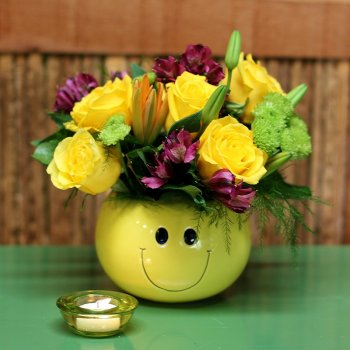
The Origins and Importance of Flower Cultivation
an article by Chris Smellie, Executive Officer of The NZ Flower Growers Association
Valentine's Day is almost on us, and inevitably gift givers will be weighing up their options. Flowers and roses in particular can suffer from the “dead in a week” concept compared with other consumer goods with greater durability. This negativity about flowers even appears in advertising at times. But these comparisons completely miss the reasons why decorative plants are cultivated and purchased, the benefits of giving and receiving flowers goes far beyond concepts of consumer durability, it is emotional!
An extensive research project
Entitled:- An Environmental Approach to Positive Emotion: Flowers was carried out by three Psychologists from the State University of New Jersey, one Psychologist from La Salle University, Philadelphia and a Geneticist from the State University of New Jersey. It is an area where there was little existing theory or research work.
The Proposition –
This research hypothesised that there is an evolutionary niche in people for emotional rewards which flowering plants have adapted to, i.e. ‘floral attraction emerged as an evolutionary strategy’. Because humans are embedded in a larger sensory and social environment than that occupied by their own species it is suggested that flowers play a role in influencing socio-emotional functions. The impact of flowers is both visual and fragrant.
Flowers are expected to convey – sympathy, romance and sexual intent, celebration i.e. pride and joy, contrition such as guilt, spiritual communications for religions and of course personal adornment. Evoking positive emotions as flowers do usually has survival benefits or conveys reproductive fitness. Positive emotion makes people appear to be more attractive, even sexually attractive, and arguably, more likely to be approached socially. Generally accepted research indicates that positive emotions produce happiness and that happiness is also related to feelings of safety and therefore associated with social gatherings and caring for infants – happy people are more likely to get married and establish families.
If flowering plants are exploiting a human emotional niche it must be shown that they directly influence people’s emotional state, happiness and social behaviour.
It was the goal of the research studies to demonstrate that some plants, notably domesticated flowers, have a strong effect on the emotional state, happiness and social behaviour in people.
The Research Methodology.
Three studies were initiated – The 1st used only female participants and coded immediate positive behaviour after being presented with various gifts, one of which of course was a bouquet of flowers. The bouquet used was mixed roses, lily and stock, a popular bouquet type with a mix of colours and odours. Recorded was a) the ‘Duchenne’ smile i.e. a smile involving the zygomatic [that involved with mouth and cheeks] and the movement of muscles orbiting the eye or b) A zygomatic smile and c) No smile? Bouquets produced more ‘Duchenne’ smiles than other gifts.
The 2nd study was extended to men as well as woman and measured emotional and social behaviour in a naturalistic observation. So again, the ‘Duchenne’ smile was important but other social indicators were measured: - proximity to the presenter, initiation of conversation and eye gaze/head orientation. This study was carried out in an elevator in which typical behaviour for sparsely occupied elevators is for strangers to retreat to opposite corners. Recipients of flowers stood closer to the flower donors and opened conversations, beyond polite exchanges, more often and made more eye contact than recipients of other gifts.
The 3rd study was somewhat more complicated and examined the long term impact of repeated exposure to flowers, [the dose effect]. So the third study looked at both short term and long term effect of flowers on - mood, the influence on social behaviour and episodic memory.
This research was extremely well constructed at every step from selection of participants to care in observation of responses and analysis of the results. Often it was conceded by the researchers that various aspects could be followed up with further research. All in all a very thorough piece of research revealing much more information than I have included in this article; the complete research article can be found here: –
http://aboutflowers.com/health-benefits-a-research/emotional-impact-of-flowers-study.html
Supposition on the Evolution of Human Cultivated Flowering Plants.
The hypothesis developed is that cultivated flowers fit into an emotional niche – their sensory properties elicit human positive emotions. The flowering plants are thereby rewarding to humans and in return, the cultivated flowers receive propagation that only humans can provide. This supports the basic significance of emotion, for survival. We are the only species that routinely digs up, divides and replants tubers bulbs and corms of flowering plants. For many plants, humans are the primary seed dispersing organisms.
How did this association arise? Initially, flowers cultivated by humans occurred in the wild in disturbed ground and were seen as weeds taking land away from cultivated crops of edible/burnable/constructive produce. If the flowers produced positive emotions they may have been allowed to remain in or near the cultivated fields with positive emotions making up for any loss of food or other production. At some point humans may have moved from merely tolerating the prettier, weedy species to actively saving and sowing the seeds. [This scenario is very like the one presented for the evolution of the relationship between dogs and humans – Flowers may be the plant equivalent of companion animals]
So flowering plants are thereby rewarding to humans and in return they receive propagation that only humans can provide. This concept supports the basic significance of emotion for survival and opens an area of investigation into the psychological relationship between humans and other species through their sensory properties, which have been relatively neglected.



 Classifieds
Classifieds

